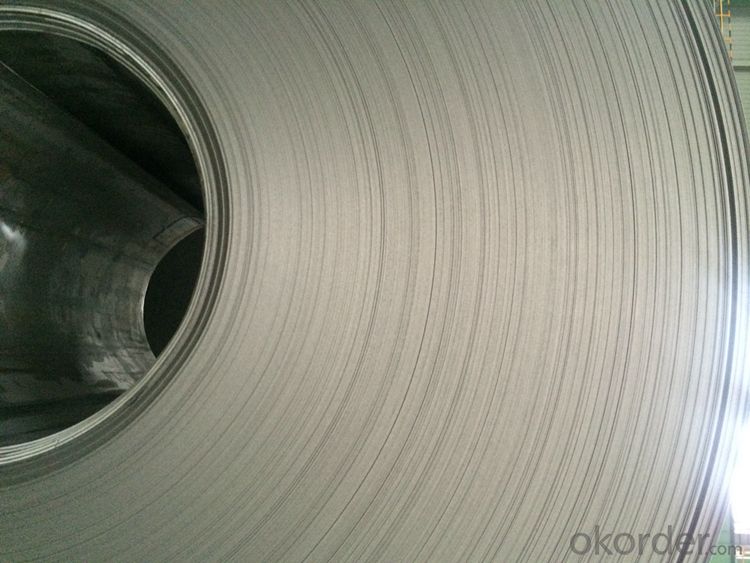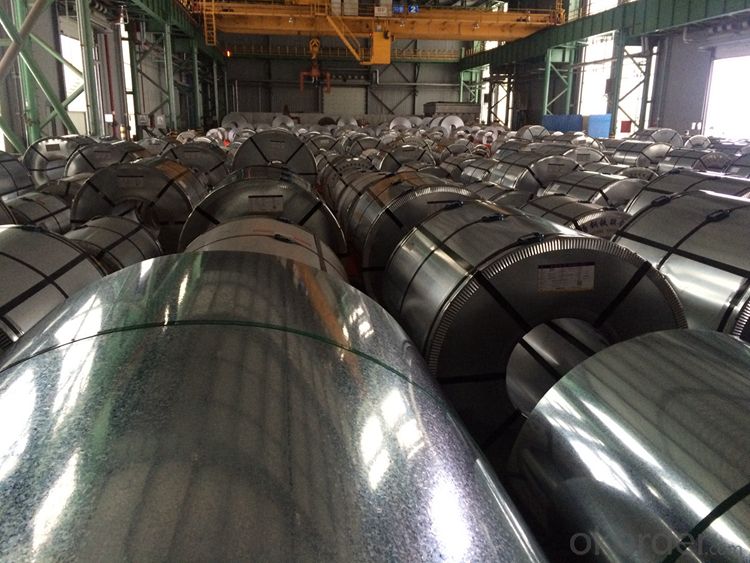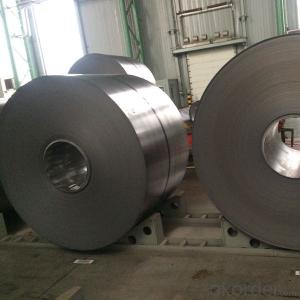Galvanized Steel Coil in China Galvanized Zinc Sheet Galvanized Steel in Coils
- Loading Port:
- Tianjin
- Payment Terms:
- TT OR LC
- Min Order Qty:
- 50 m.t.
- Supply Capability:
- 20000 m.t./month
OKorder Service Pledge
OKorder Financial Service
You Might Also Like
Item specifice
DESCRIPTION FOR GALVANIZED STEEL COILS:
Mian Quality Standard | JIS G3302, EN10346, DIN17162, ASTM A653/653M, GB2518 |
Process | hot dip galvanizing |
Process Speed | 1#. Max 120m/min, 2#. Max 130m/min |
Thickness | 1#. 0.25mm upto 1.20mm, 2#. 0.25mm upto 1.0mm |
Width | 900mm upto 1300mm |
Surface Finish | zero spangles, skinpassed, oiled,chromated, tension level, |
Coating | zinc layer mass on both sides from 30 g/m2 upto 180g/m2 |
Yield Strength | 220Mpa upto 750Mpa |
Weight per Coil | max 15,000kg |
Inner Diameter | φ 508mm |
Outer Diameter | max φ 2,050mm |
Finished Internal Diameter | Φ 508mm or φ 610mm |
Finished Coil Weight | 1#. max 10,000kg, 2#. max 15,000kg |
Packing | Mill's Export Standard Packing |
Capacity | 300,000 tons/year |
EXPORT STANDARD FOR GALVANIZED STEEL COILS:
-Axial and circumferential steel straps with seal (4 steel straps each)
-VCI Anti-rust kraft paper
-Water-proofing plastic
-Pearl wool (coil surface)
-Steel cover (coil surface/bore)
-Plastic cover (coil sides)
-Inside and outside corner protectors
Or According customers' requirements(Usually only for domestic)
PACKAGING &DELIVERY FOR GALVANIZED STEEL COILS:
Packaging Detail Standard export packing or following customer's demand
Delivery Time: Within 30-40 days after deposit or according to the order quantity
PACKAGING &DELIVERY FOR GALVANIZED STEEL COILS:
1.Big thickness:by bulk vessel
2.Small thickness:packed by steel strips and shipped by container
3.According to the requirements of customers'
TRADE TERMS FOR GALVANIZED STEEL COILS:FOB, CFR, CIF
DETAILED PICTURES FOR GALVANIZED STEEL COILS:


APPLICATION FOR GALVANIZED STEEL COILS:
Galvanized steel products are mainly used in construction, light industry, automobile, agriculture , fishery and commercial industries. They have great advantages:1.it has small harm to the environment and it can be recycled, greatly lighten the stress to the environment.2.it is convenient to process,easy to construct and has good waterproof effect.
FAQ FOR GALVANIZED STEEL COILS:
Q:Do you have OEM service?
A: Yes.Variety of products size,quality and quantity can be customized according to your need.
Q:Could you support free sample?
A:Yes.We can supply FREE samples.But the delivery charges will be covered by our customers.
- Q:What are the benefits of using patterned stainless steel sheets in interior design?
- Patterned stainless steel sheets offer several benefits in interior design. Firstly, they add visual interest and uniqueness to a space, allowing for creative and innovative design possibilities. The patterns can range from subtle to bold, providing options to suit various aesthetics and design themes. Additionally, stainless steel is a durable material that is resistant to corrosion, making it ideal for high-traffic areas or spaces prone to moisture. It is also easy to clean, making maintenance hassle-free. The reflective properties of stainless steel can also help to brighten a room and create an illusion of increased space. Furthermore, patterned stainless steel sheets are versatile and can be used in various applications, such as wall coverings, backsplashes, countertops, or even furniture accents. They can be used to enhance both modern and traditional interior designs, adding a touch of sophistication and elegance. Overall, the benefits of using patterned stainless steel sheets in interior design include their aesthetic appeal, durability, ease of maintenance, versatility, and ability to enhance the overall visual appeal of a space.
- Q:How do you bend stainless steel sheets?
- To effectively bend stainless steel sheets, a combination of skill, knowledge, and the right tools is necessary. Follow these steps for successful bending: 1. Identify the specific grade of stainless steel you are working with as each grade possesses unique characteristics affecting malleability and bending response. 2. Prior to bending, ensure the stainless steel sheet is clean and devoid of any dirt or debris. Use a mild detergent and a soft cloth for surface cleaning. 3. Mark the precise bending line by measuring and indicating the desired spot. Utilize a ruler or straight edge for accuracy. 4. Select an appropriate bending tool based on the size and thickness of the stainless steel sheet. Options include a press brake, rolling machine, or bending machine. 5. Gradually apply pressure by placing the stainless steel sheet in the bending tool, aligning it with the marked bending line. Avoid excessive force to prevent cracking or deformation. 6. Adjust the bending angle as needed by repositioning the stainless steel sheet within the bending tool. Utilize the tool's adjustments or supplementary tools like clamps for precise angles. 7. Inspect the result by carefully removing the stainless steel sheet from the bending tool. Check for defects, cracks, or unevenness. Minor adjustments can be made using a rubber mallet or a hammer with a soft face. Keep in mind that bending stainless steel sheets requires practice and precision. Begin with smaller projects and gradually advance to more complex bends. If uncertain or lacking experience, consult a professional in metal fabrication for the best outcomes.
- Q:Are stainless steel sheets available in different patterns?
- Yes, stainless steel sheets are available in different patterns.
- Q:Can stainless steel sheets be used in decorative applications?
- Certainly, decorative applications can certainly make use of stainless steel sheets. Stainless steel possesses great versatility, allowing it to be shaped, patterned, and finished in a variety of ways, rendering it an exceptional option for decorative purposes. Its sleek and contemporary look adds a dash of sophistication to any area, and it can be utilized in a multitude of ways, such as wall cladding, backsplashes, cabinet fronts, countertops, and furniture embellishments. Moreover, stainless steel sheets exhibit remarkable durability, resistance to corrosion, and ease of maintenance, making them an ideal choice for both indoor and outdoor decorative applications.
- Q:Are stainless steel sheets suitable for petrochemical refineries?
- Stainless steel sheets are indeed appropriate for petrochemical refineries. They are an incredibly durable material that can endure harsh conditions and extreme temperatures, making them perfect for use in such facilities. This type of steel provides exceptional resistance to chemicals, acids, and caustic substances commonly found in the refining process. Moreover, stainless steel sheets possess outstanding mechanical properties, enabling them to withstand high pressure and stress, thereby ensuring longevity and dependability in refinery operations. Additionally, the non-porous surface of stainless steel prevents the accumulation of bacteria and other contaminants, making it both hygienic and easy to clean. All in all, due to their remarkable corrosion resistance, mechanical strength, and ease of maintenance, stainless steel sheets are the preferred choice in petrochemical refineries.
- Q:Can stainless steel sheets be used for architectural cladding?
- Architectural cladding can indeed utilize stainless steel sheets. This material is incredibly versatile and offers numerous benefits for architectural applications. It boasts exceptional corrosion resistance, making it suitable for both interior and exterior cladding in diverse environments. Furthermore, stainless steel sheets are highly durable and require minimal maintenance, making them ideal for long-term use in architectural projects. Moreover, architects can achieve their desired aesthetic as stainless steel can be finished in various ways, enhancing its attractive appearance. Additionally, stainless steel's remarkable strength and fire resistance properties further enhance its suitability for architectural cladding. All in all, stainless steel sheets are a favored choice for architectural cladding due to their durability, resistance to corrosion, aesthetic appeal, and versatility.
- Q:Can stainless steel sheets be used for air conditioning systems?
- Yes, stainless steel sheets can be used for air conditioning systems. Stainless steel is a popular material choice for various components in air conditioning systems due to its durability, resistance to corrosion, and high strength. It is commonly used for air conditioning ducts, air handling units, heat exchangers, and other parts that come into contact with air or moisture. The stainless steel sheets used in air conditioning systems are typically of a specific grade that is suitable for the intended application, ensuring optimal performance and longevity. Overall, stainless steel sheets are a reliable and efficient choice for air conditioning systems.
- Q:Are stainless steel sheets good for pressure vessels?
- Stainless steel sheets have gained popularity as a preferred choice for pressure vessels due to their durability, reliability, and ability to meet the demanding requirements of such applications. Commonly employed, they are considered to be an excellent option. Stainless steel possesses exceptional resistance to corrosion, high strength, and commendable mechanical properties, rendering it suitable for applications that necessitate withstanding high pressures. Moreover, stainless steel exhibits remarkable heat resistance, a pivotal trait in pressure vessels where exposure to elevated temperatures is likely. It is also important to highlight that stainless steel lends itself to easy formation and welding, facilitating the fabrication of intricate shapes and designs required for pressure vessel construction. All in all, stainless steel sheets are a favored material for pressure vessels due to their ability to endure, their dependability, and their capacity to fulfill the demanding prerequisites of such applications.
- Q:How do I prevent intergranular corrosion on stainless steel sheets?
- To prevent intergranular corrosion on stainless steel sheets, there are several steps that can be taken: 1. Opt for the appropriate stainless steel grade: Choose stainless steel grades that are specifically designed to resist intergranular corrosion, such as 304L, 316L, or 321. These grades have a lower carbon content, which minimizes the formation of chromium carbides at grain boundaries. 2. Apply heat treatment: After fabrication or welding, subject the stainless steel sheets to a solution annealing or post-weld heat treatment process. This treatment eliminates any chromium carbides that may have formed during welding or high-temperature processing, effectively preventing intergranular corrosion. 3. Avoid high temperature exposure: It is crucial to avoid subjecting stainless steel sheets to temperatures between 450 to 850 degrees Celsius (842 to 1562 degrees Fahrenheit) for extended periods. Prolonged exposure to such temperatures can lead to the formation of chromium carbides at the grain boundaries, rendering the stainless steel susceptible to intergranular corrosion. 4. Utilize proper welding techniques: When welding stainless steel sheets, it is important to employ low heat input and minimize the duration of exposure to high temperatures. These measures help reduce the formation of chromium carbides and preserve the corrosion resistance of the stainless steel. 5. Employ pickling and passivation: After fabrication or welding, ensure that the stainless steel sheets undergo thorough pickling and passivation. Pickling removes any surface contaminants, while passivation forms a protective oxide layer that prevents intergranular corrosion. 6. Regularly maintain and clean: To prevent potential corrosion, it is essential to keep the stainless steel sheets clean and free from contaminants. Regularly clean the surfaces using mild detergents and avoid the use of harsh chemicals or abrasive materials that may damage the protective oxide layer. By following these preventative measures, the risk of intergranular corrosion on stainless steel sheets can be significantly reduced, allowing for the preservation of their corrosion resistance properties and an extended lifespan.
- Q:Can stainless steel sheets be used for brewery equipment?
- Yes, stainless steel sheets can be used for brewery equipment. Stainless steel is a popular choice for brewery equipment due to its corrosion resistance, durability, and hygienic properties. It is resistant to the chemicals and acids commonly used in brewing processes and does not react with beer, ensuring the taste and quality of the final product. Stainless steel sheets can be used to fabricate various brewery equipment such as fermentation tanks, bright tanks, mash tuns, hot liquor tanks, and piping systems. Additionally, stainless steel is easy to clean and maintain, making it an ideal material for brewery equipment where sanitation is crucial.
1. Manufacturer Overview |
|
|---|---|
| Location | |
| Year Established | |
| Annual Output Value | |
| Main Markets | |
| Company Certifications | |
2. Manufacturer Certificates |
|
|---|---|
| a) Certification Name | |
| Range | |
| Reference | |
| Validity Period | |
3. Manufacturer Capability |
|
|---|---|
| a)Trade Capacity | |
| Nearest Port | |
| Export Percentage | |
| No.of Employees in Trade Department | |
| Language Spoken: | |
| b)Factory Information | |
| Factory Size: | |
| No. of Production Lines | |
| Contract Manufacturing | |
| Product Price Range | |
Send your message to us
Galvanized Steel Coil in China Galvanized Zinc Sheet Galvanized Steel in Coils
- Loading Port:
- Tianjin
- Payment Terms:
- TT OR LC
- Min Order Qty:
- 50 m.t.
- Supply Capability:
- 20000 m.t./month
OKorder Service Pledge
OKorder Financial Service
Similar products
New products
Hot products
Related keywords
































